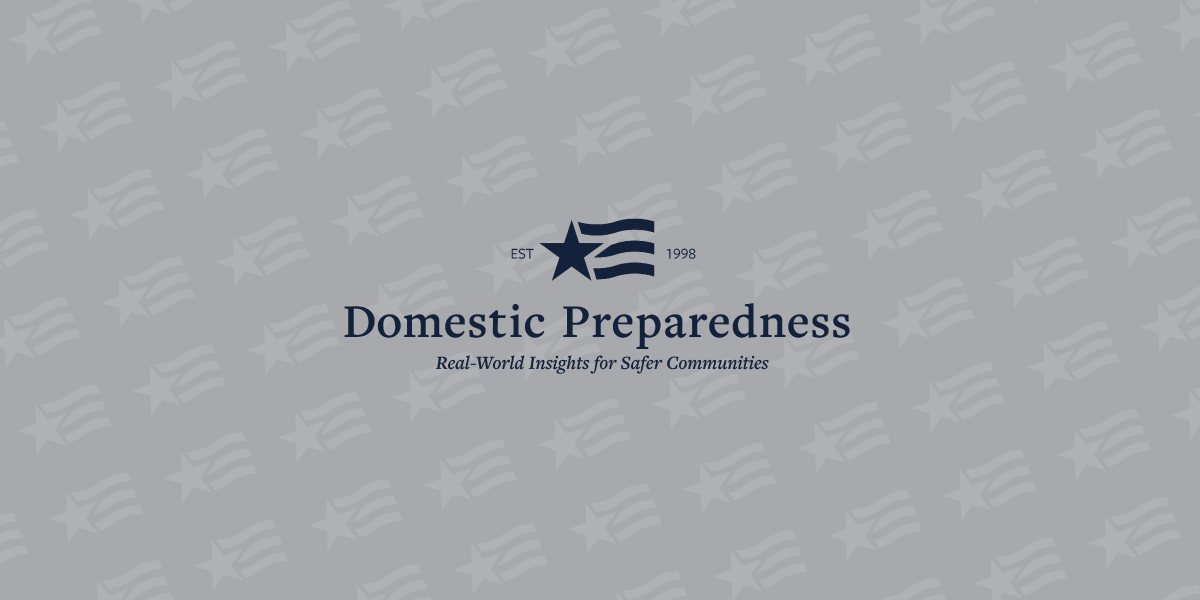Most recently published

Making Planning Documents More Than Words on Paper
Andrew (Andy) Altizer
May 17, 2023
President Harry S. Truman once said, “I believe in plans big enough to meet a situation which we can’t possibly foresee now.” However, terms like big and comprehensive do not always equate to size. Something that is laborious and unread adds no value for those tasked with managing emergencies and disasters. However,

Defining Workplace Violence
Kevin Jones
May 17, 2023
History has shown many instances where warning signs were missed before workplace violence occurred. However, understanding the five categories can help organizations and agencies prepare for and, ideally, prevent these types of incidents.

Challenges With Pediatric Mass Care Feeding
Michael Prasad and Jennifer Russell
May 10, 2023
The national-level guidance on mass care feeding for state, local, tribal, and territorial organizations (SLTTs) comes from the Federal Emergency Management Agency (FEMA), and is sourced from their toolkits and the National Mass Care Strategy website, which provides a consolidated and comprehensive set of guidance material from governmental and nongovernmental mass care experts. The

Keeping Schools Safe During the Threat of Nuclear Attacks
Tanya M. Scherr and Dan Scherr
May 10, 2023
The hands of the so-called Doomsday Clock are now set to 90 seconds to midnight, reflecting that experts believe the world is closer to a global nuclear catastrophe than it has ever been. All-hazards plans and threat assessments should reflect this potential increased threat.

Labor Trafficking – The Case Study of Marco
Richard Schoeberl, Anthony (Tony) Mottola and David Gonzalez
May 3, 2023
Countless immigrants like Marco do not self-identify as labor trafficking victims, yet this increasing crime needs to be addressed. Learn how communities can better protect these vulnerable populations.

Perfect Storm: Albuterol Shortage & Supply Chain Upset
Tom Cotter
May 3, 2023
As of 2020, albuterol was the seventh most commonly prescribed medication in the U.S., with more than an estimated 17 million patients receiving it and nearly 62 million prescriptions issued annually. Albuterol is a short-acting bronchodilator drug that helps treat or prevent respiratory issues by relaxing the smooth muscles in

Planning for Future Events Requires Updated Plans
Catherine L. Feinman
April 26, 2023
Threats, hazards, and risks change over time as numerous variables change. This means preparedness professionals must be forward-thinking when planning for emergencies and disasters. Past events can teach valuable lessons for the future, and sometimes those lessons include adapting old plans to meet new or emerging challenges. The authors in

Eclipses Again Will Darken the Sky in 2023 and 2024
Laurel J. Radow
April 26, 2023
An eclipse is not just about the sky getting dark. There are many considerations for emergency planners and public safety professionals to ensure the safety of their communities. Learn the lessons from the 2017 eclipse to better prepare for the next event.

Preparedness Promoters – Assessing Marginalized Populations
Maxwell Palmer
April 26, 2023
Certain populations are more vulnerable when faced with disasters. By adapting a public health model, community leaders can identify common vulnerability indicators and close the gaps between emergency management plans and target population vulnerabilities. Learn how.

Covenant School – Reviewing Another Tragic Shooting
Tanya M. Scherr and Dan Scherr
April 19, 2023
The Covenant School shooting is another reminder of active shooter trends. This article reviews the chain of events from that tragic event, post-incident reviews, and what communities are and should be doing to prepare for and prevent future active shooter incidents.

Labor Trafficking – An Underreported Escalating Crisis
Richard Schoeberl, David Gonzalez and Anthony (Tony) Mottola
April 19, 2023
Labor trafficking affects many more people in the U.S. than sex trafficking, but it gets much less attention. Learn what the government is doing and what else community stakeholders can do now to better protect people from this growing threat.

The DoD Defense Coordinating Element and How It Is Certified
Patrick McNiece
April 12, 2023
Besides the main mission of defending the homeland, Department of Defense capabilities also provide critical support to local, state, and federal civilian partners during major disasters. Learn how Army North’s defense coordinating element’s mission and composition ready their units to perform this additional mission when needed.

Helping First Responders & the Public Bring Home Missing Kids
Michael Breslin and Trish McCall
May 24, 2023
An existential danger is the exploitation of children. As the threat landscape evolves, first responders have a paramount role to play in protecting these vulnerable populations and maintaining a resilient homeland security enterprise. One program leading the effort is creating a reason for hope.

Making Planning Documents More Than Words on Paper
Andrew (Andy) Altizer
May 17, 2023
President Harry S. Truman once said, “I believe in plans big enough to meet a situation which we can’t possibly foresee now.” However, terms like big and comprehensive do not always equate to size. Something that is laborious and unread adds no value for those tasked with managing emergencies and disasters. However,

Defining Workplace Violence
Kevin Jones
May 17, 2023
History has shown many instances where warning signs were missed before workplace violence occurred. However, understanding the five categories can help organizations and agencies prepare for and, ideally, prevent these types of incidents.

Challenges With Pediatric Mass Care Feeding
Michael Prasad and Jennifer Russell
May 10, 2023
The national-level guidance on mass care feeding for state, local, tribal, and territorial organizations (SLTTs) comes from the Federal Emergency Management Agency (FEMA), and is sourced from their toolkits and the National Mass Care Strategy website, which provides a consolidated and comprehensive set of guidance material from governmental and nongovernmental mass care experts. The

Keeping Schools Safe During the Threat of Nuclear Attacks
Tanya M. Scherr and Dan Scherr
May 10, 2023
The hands of the so-called Doomsday Clock are now set to 90 seconds to midnight, reflecting that experts believe the world is closer to a global nuclear catastrophe than it has ever been. All-hazards plans and threat assessments should reflect this potential increased threat.

Labor Trafficking – The Case Study of Marco
Richard Schoeberl, Anthony (Tony) Mottola and David Gonzalez
May 3, 2023
Countless immigrants like Marco do not self-identify as labor trafficking victims, yet this increasing crime needs to be addressed. Learn how communities can better protect these vulnerable populations.

Perfect Storm: Albuterol Shortage & Supply Chain Upset
Tom Cotter
May 3, 2023
As of 2020, albuterol was the seventh most commonly prescribed medication in the U.S., with more than an estimated 17 million patients receiving it and nearly 62 million prescriptions issued annually. Albuterol is a short-acting bronchodilator drug that helps treat or prevent respiratory issues by relaxing the smooth muscles in

Planning for Future Events Requires Updated Plans
Catherine L. Feinman
April 26, 2023
Threats, hazards, and risks change over time as numerous variables change. This means preparedness professionals must be forward-thinking when planning for emergencies and disasters. Past events can teach valuable lessons for the future, and sometimes those lessons include adapting old plans to meet new or emerging challenges. The authors in

Eclipses Again Will Darken the Sky in 2023 and 2024
Laurel J. Radow
April 26, 2023
An eclipse is not just about the sky getting dark. There are many considerations for emergency planners and public safety professionals to ensure the safety of their communities. Learn the lessons from the 2017 eclipse to better prepare for the next event.

Preparedness Promoters – Assessing Marginalized Populations
Maxwell Palmer
April 26, 2023
Certain populations are more vulnerable when faced with disasters. By adapting a public health model, community leaders can identify common vulnerability indicators and close the gaps between emergency management plans and target population vulnerabilities. Learn how.

Covenant School – Reviewing Another Tragic Shooting
Tanya M. Scherr and Dan Scherr
April 19, 2023
The Covenant School shooting is another reminder of active shooter trends. This article reviews the chain of events from that tragic event, post-incident reviews, and what communities are and should be doing to prepare for and prevent future active shooter incidents.

Labor Trafficking – An Underreported Escalating Crisis
Richard Schoeberl, David Gonzalez and Anthony (Tony) Mottola
April 19, 2023
Labor trafficking affects many more people in the U.S. than sex trafficking, but it gets much less attention. Learn what the government is doing and what else community stakeholders can do now to better protect people from this growing threat.
Hazmat on the Rail
Glen Rudner
April 5, 2023
Since February 3, 2023, following the train derailment in East Palestine, Ohio, the public has closely followed reports and commentary by media outlets and elected officials. This incident has become more controversial and publicized than others in recent years and has caused a public outcry for change.
Preparing the Next Generation for Increasing Disasters
Kay C. Goss
April 5, 2023
Preparing the next generation of emergency preparedness and response professionals requires educational programs that teach critical thinking and life-saving strategies. Many programs and resources address these needs, but more educational and collaborative opportunities should be considered to meet the growing needs.
Information Sharing – A Powerful Life-Saving Tool
Catherine L. Feinman
March 29, 2023
Information sharing is a valuable tool used for various purposes. However, this tool’s power in preparing for and responding to emergencies should not be underestimated. Unfortunately, critical information and data can sometimes be misused, not effectively leveraged, not shared, or simply ignored. In these scenarios, it is more difficult to
Guidance for Preparing Professionals Mentally for the Worst
James Greenstone and Weldon Walles
March 22, 2023
Professional groups have debated and researched the best practices relating to the standards and quality of care sufficient to maintain minimum standards during a disaster. Due to the fluid nature of a disaster, it is difficult to abide by a standard that will fit every situation. For example, the onset
Challenging the Next Generation to Communicate Preparedness
Chris Sheach
March 22, 2023
No single communication solution can apply to every situation. To better prepare the next generation of public safety professionals, one professor is challenging young adults to develop social media messaging that reaches diverse populations and encourages action to protect lives and property during emergencies.
A National Plan to Link Response and Recovery
Robert J. (Bob) Roller
March 15, 2023
In March 2023, FEMA published the Response and Recovery Federal Interagency Operational Plan. Learn about this big step forward for the emergency management community – the development and content of this new plan as well as the next steps for key stakeholders.
Tornadoes – Adapting Plans for a Changing Environment
Cameron Gonteski
March 15, 2023
Common terms like “Tornado Alley” should not get in the way of planning for evolving environmental threats. Meteorologists look at trends and recognize that tornadoes are one natural hazard that is shifting eastward. Make sure state and local hazard mitigation plans are updated and ready for this shift.
Leader of the Pack – Canine Detection
Barb Clark
March 8, 2023
In the wake of a disaster, time is critical for locating survivors and recovering bodies. This type of work requires training, skills, and abilities acquired by canines due to their unique anatomy and physiology. However, there are key considerations before implementing K9 programs.
Fostering Public Buy-In to Support Public Safety
Taylor Bonsall-Winn
March 8, 2023
Emergency managers often go unnoticed until a disaster occurs. However, disaster response efforts are much more effective when communities work together and trust their local responding agencies. Learn how one county has changed its mindset to develop stronger community partnerships and buy-in before the next disaster.
An Integrated Public Safety Approach for Evolving Threats
Eva Jernegan
March 1, 2023
Evolving threats require integrated public safety approaches. Concepts like the Rescue Task Force, models like the Cynefin Framework, and numerous other available resources can help communities develop collaborative response plans for evolving threats and complex coordinated attacks like fire as a weapon.
Data Sharing – A Necessary Public Safety Tool
Michael Breslin
March 1, 2023
Criminal activities are not limited to jurisdictional boundaries, nor should the ability to share information collaboratively. Cooperative data sharing within and between jurisdictions is essential for today’s law enforcement demands. As such, law enforcement and other public safety agencies must work together to create a safer and more just society.
Technological Strategies for Organizational Leadership
Nathan DiPillo
February 22, 2023
Article Out Loud Integrating information technology (IT) into emergency management and public safety agencies involves balancing technological limitations with the organizational mindset. Finding this balance has been discussed in practice, academia, and across multiple disciplines, with friction sometimes emerging between the leadership mindset, staff, data, training, and implementation. For example,
Follow Us
Get Instant Access
Subscribe today to Domestic Preparedness and get real-world insights for safer communities.


